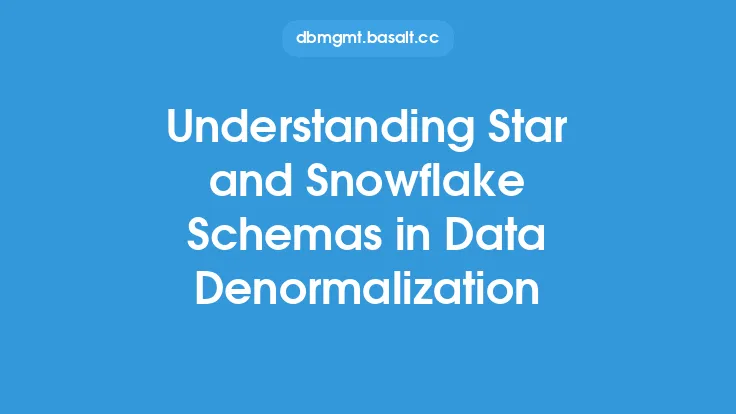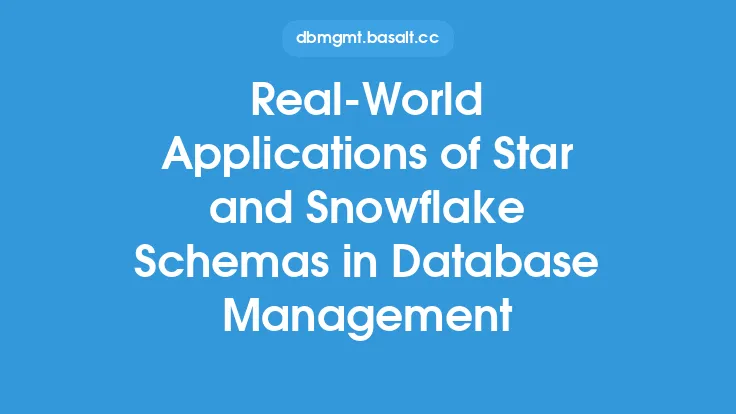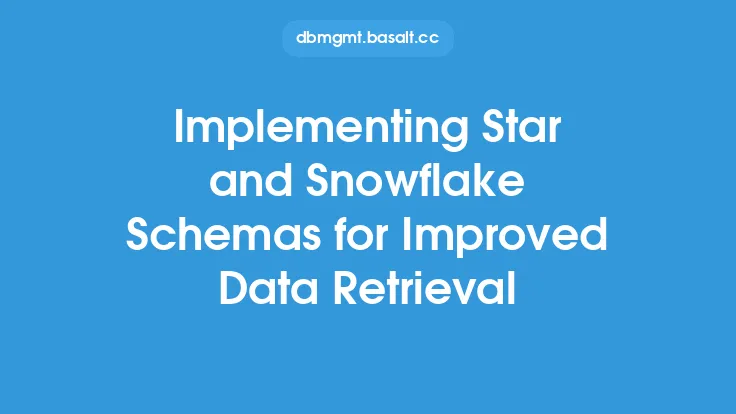Data denormalization is a crucial aspect of database design, particularly in data warehousing and business intelligence applications. It involves organizing data in a way that improves query performance, reduces data redundancy, and enhances data retrieval. Two popular schema designs used in data denormalization are star and snowflake schemas. These schemas have been widely adopted in various industries due to their ability to optimize data storage and retrieval. In this article, we will delve into the benefits of using star and snowflake schemas in data denormalization, exploring their advantages, and discussing how they can be effectively implemented.
Introduction to Star Schemas
Star schemas are a type of denormalized database design that consists of a central fact table surrounded by dimension tables. The fact table contains measurable data, such as sales or website traffic, while the dimension tables provide context to the data, including time, location, and product information. Star schemas are ideal for data warehousing and business intelligence applications, as they enable fast query performance and efficient data retrieval. The benefits of star schemas include improved query performance, reduced data redundancy, and enhanced data aggregation.
Introduction to Snowflake Schemas
Snowflake schemas are an extension of star schemas, where each dimension table is further normalized into multiple related tables. This design is useful when there are multiple levels of granularity in the dimension data. For example, a date dimension table might be normalized into separate tables for year, quarter, month, and day. Snowflake schemas offer additional benefits, including improved data flexibility, reduced data redundancy, and enhanced data granularity. However, they can also increase complexity and require more maintenance than star schemas.
Benefits of Star and Snowflake Schemas
The benefits of using star and snowflake schemas in data denormalization are numerous. One of the primary advantages is improved query performance. By denormalizing data and reducing joins, star and snowflake schemas enable faster query execution and improved data retrieval. Additionally, these schemas reduce data redundancy, which can lead to data inconsistencies and errors. Star and snowflake schemas also enhance data aggregation, making it easier to perform complex calculations and analysis.
Data Retrieval and Query Performance
Star and snowflake schemas are optimized for data retrieval and query performance. The denormalized design reduces the number of joins required to retrieve data, resulting in faster query execution. Additionally, the use of fact and dimension tables enables efficient data aggregation and filtering. This is particularly important in data warehousing and business intelligence applications, where fast query performance is critical for decision-making.
Data Flexibility and Granularity
Snowflake schemas, in particular, offer improved data flexibility and granularity. By normalizing dimension tables into multiple related tables, snowflake schemas enable more detailed analysis and reporting. This is useful in applications where data needs to be analyzed at multiple levels of granularity, such as sales data by region, product, and time.
Data Maintenance and Complexity
While star and snowflake schemas offer numerous benefits, they also require more maintenance and can increase complexity. The denormalized design requires careful data management to ensure data consistency and accuracy. Additionally, snowflake schemas can be more complex to design and maintain, particularly for large datasets. However, the benefits of improved query performance and data flexibility often outweigh the additional maintenance requirements.
Real-World Applications
Star and snowflake schemas have numerous real-world applications in data warehousing, business intelligence, and big data analytics. They are used in various industries, including retail, finance, healthcare, and telecommunications. For example, a retail company might use a star schema to analyze sales data by region, product, and time, while a financial institution might use a snowflake schema to analyze customer data by demographic, behavior, and transaction history.
Best Practices for Implementation
To effectively implement star and snowflake schemas, several best practices should be followed. First, carefully design the schema to ensure data consistency and accuracy. Second, use data warehousing and business intelligence tools to optimize query performance and data retrieval. Third, regularly maintain and update the schema to ensure data freshness and relevance. Finally, consider using data governance and data quality tools to ensure data accuracy and consistency.
Conclusion
In conclusion, star and snowflake schemas are powerful tools for data denormalization, offering numerous benefits, including improved query performance, reduced data redundancy, and enhanced data flexibility. While they require more maintenance and can increase complexity, the benefits often outweigh the additional requirements. By understanding the benefits and best practices for implementation, organizations can effectively use star and snowflake schemas to optimize data storage and retrieval, and improve decision-making. As data continues to grow in volume and complexity, the use of star and snowflake schemas will become increasingly important for organizations seeking to extract insights and value from their data.





